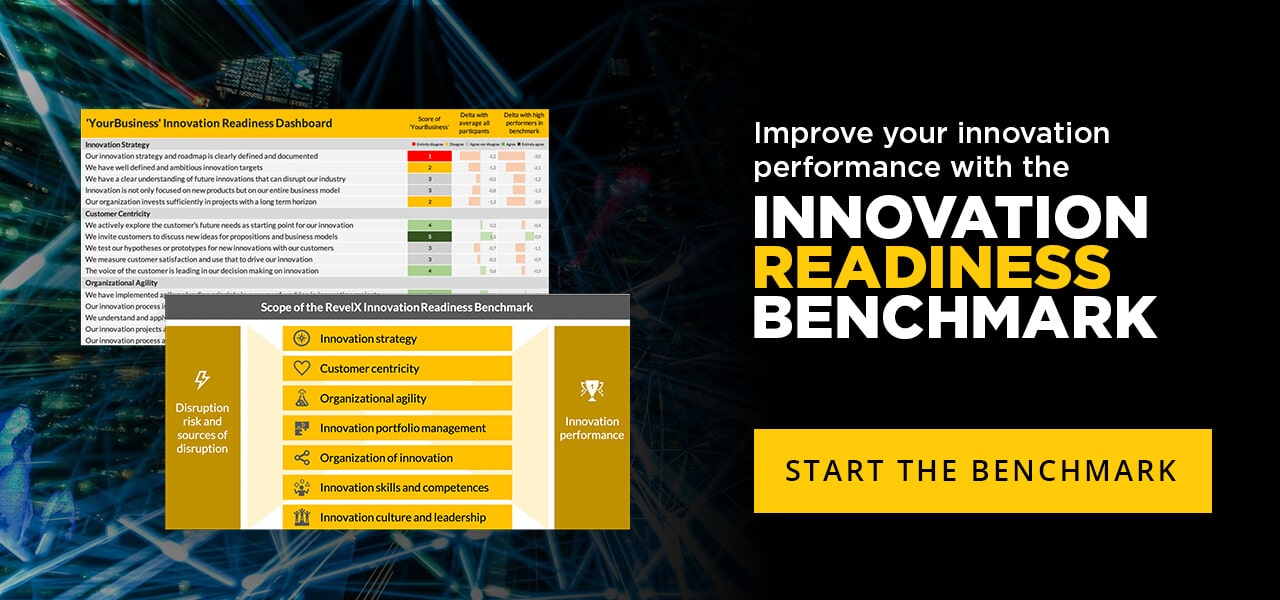Facing too many innovation projects and having difficulties killing your darlings?
Here’s how to clean up your innovation portfolio and why you should.
Many companies work on too many innovations
In our daily practice we meet many board members and senior managers with a responsibility for innovation, walking around feeling like being a Chinese ‘plate spinning’ artist. In their company’s strive for innovation, combined with a well-developed amount of optimism, every innovative idea gets a chance, leading to an innovation portfolio that is almost impossible to manage.
And given the difficulties in leading innovations from ideation towards scale up, an out-of-control innovation portfolio is the last thing you need.
Our own research suggests that over 50% of companies do not manage their total portfolio of innovations (properly).
How to recognise failing innovation portfolio management
Many organisations struggling with an out-of-control portfolio of innovations don’t even realise what happens. Here are some symptoms which are leading indicators for innovation-portfolio management issues:
- ‘Innovation’ is not clearly defined in the organization
- The status of innovation projects is unclear
- Expected return on innovations is unclear
- Innovation teams get insufficient management attention or support
- Innovation projects fight for scarce resources
- Innovation projects have unclear targets
- Innovation projects are not pro-actively terminated
Now don’t get us wrong, suffering from one or more of the above listed issues does not mean that lacking portfolio management is the root cause of all of this. There may be other issues hindering your innovation process. In the Corporate Innovation playbook, you will find the following five key reasons for disappointing innovation performance:
- Innovation theatre
- Strategy dis-connect
- Not invented here syndrome
- Low risk appetite and failure acceptance
- Lack of data culture
Whatever the cause of your disappointing innovation performance may be, it’s always a good idea to clean up, whether it’s your house, your office, or your innovation portfolio. Because if you don’t clean up, things will finally get messy. In the end, innovation means saying ‘no’ to a thousand things.
What happens if you don’t solve this
As too many senior executives and board members are already quite sceptical towards innovation, an out-of-control innovation portfolio will fuel their concerns about bottom-line results. Or as the former CEO of one of our clients used to phrase it (on a daily basis): “How many more products will we sell today with this innovation?”
The point we like to make is that without proper innovation portfolio management, you will not be able to clearly show what innovations you are working on, what these innovations may contribute to the business, what investment decisions are being taken, and so forth. Without this information you cannot expect any sane executive to continue investing, hence your entire innovation function may be at risk.

How to clean up your innovation portfolio
Having said that, cleaning up your innovation portfolio is not an easy task. It is of the greatest importance that a well-balanced mix of criteria is applied. In most cases we come across we find the following set of criteria will do the trick:
- Demand uncertainty: How certain or uncertain is it that there will be an external or internal demand for your innovation and how big could the demand be? What would be the potential revenue?
- Realisation uncertainty: How certain or uncertain are you that you will be able to actually realise the innovation and what would be the total potential? What investments may be needed?
- Innovation domain: In what business domain lies your innovation? Is it an innovation in your core product & services offering, in your business model or in your customer engagement strategy?
- Innovation phase: In what business maturity phase from initial conception of the idea to full maturity does the innovation currently sit? What would be the lead-time towards full maturity or towards breakeven?
Ranking your innovations on these criteria will give you a clear overview of the overall balance in your portfolio. It will provide insight on how to manage it. For example, projects with low demand and realisation uncertainty are never innovations in the first place. They are improvements and should not clutter the innovation portfolio. Ultimately, it will help you prune your innovation portfolio: what projects to kill and which ones to provide with extra fuel.
Now what?
Should you want to read more on this topic, or start the rationalisation of your own innovation portfolio, we recommend the following:
Read our book ‘DARE, The mindset for successful innovators in the digital age’.
- Especially section 2, “Am I still in business in 5 years’ time” contains interesting information on portfolio management, page 66 and onwards, especially the demand and realisation uncertainty framework is explained.
- Page 65 provides a useful framework for determining in what business maturity phase your innovation currently sits.
- Page 127 contains a framework for innovation domains and shows in what business domains innovations can be realised.
Of course, you can always give us a call to discuss any innovation portfolio challenges you may have.
Our colleague Eric de Groot will be more than happy to share insights and experience. eric@revelx.nl or +31655196508
Matthijs Rosman
Trusted and creative advisor. Specialist in growth acceleration and innovation. Combines analysis and creativity to develop surprising combinations. From new digital possibilities to ways to improve commercial results. Cordial towards others, sharp on details. Continuously looking for growth opportunities.
Related posts
How to Prevent Innovation Theatre
Learn how real innovation drives success and avoid the…
June 21, 2024
Corporate Innovation: A Catalyst for Success
In the dynamic and competitive business landscape,…
June 7, 2024
Stepping Through Your Stage Gates Like a Pro
Stages, stage gates and making stage gate decisions. This…
March 8, 2023



